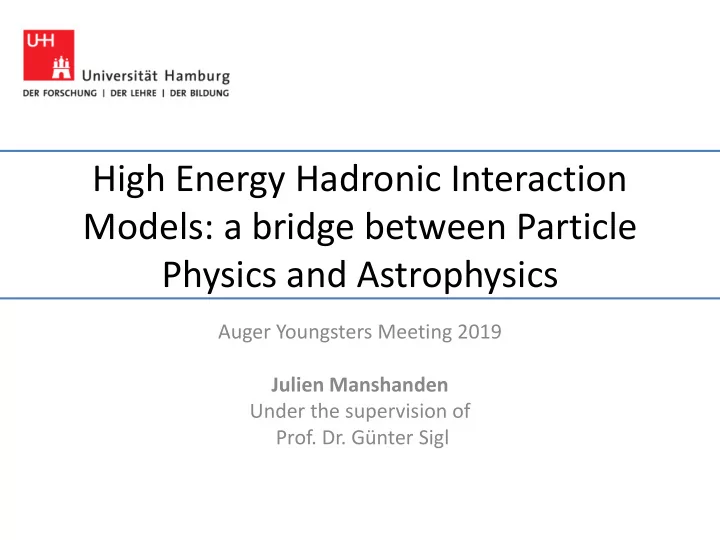

High Energy Hadronic Interaction Models: a bridge between Particle Physics and Astrophysics Auger Youngsters Meeting 2019 Julien Manshanden Under the supervision of Prof. Dr. Günter Sigl
Outline • Motivation • Muon Deficit • Fireball Model – Anchordoqui, Goldberg & Weiler Anchordoqui et al. (2017), arXiv:1612.07328 • Longitudinal Muon Dist. • Muon Number at Ground, R μ • Discussion • Outlook 1/12
Motivation Inference of CR properties EAS Measured observables: - X max Pierre Auger UHECR - N μ Observatory - … Inferring CR properties Expected observables: Input CR MC EAS - X max properties MC MC Simulation - N μ - … 2/12
Motivation ON EQUAL FOOTING Constraining high energy, high p T particle physics EAS Measured observables: - X max Pierre Auger UHECR - N μ Observatory - … Constraining HE HIM Expected observables: Input CR MC EAS - X max properties MC MC Simulation - N μ - … HE HIM Particle Physics 3/12
Muon Deficit Figures from: Aab et al. (Pierre Auger Collab.) 2015 • Significantly more muons observed than predicted by EAS simulations • Not compatible with X max observations • Clear inconsistency in current air shower models New physics? New first interaction? 4/12
Fireball Model – Anchordoqui, Goldberg & Weiler Anchordoqui et al. (2017), arXiv:1612.07328 • Production of a new “ fireball ” state after the first interaction • Fragmentation of gluons into ss ̄ pairs • Suppression of pion production • Net effect: enhanced ratio of energy in hadronic to electromagnetic component Mimick model with procedure from Soriano et al. (2018), arXiv:1811.07728 5/12
Longitudinal Muon Dist. To attenuate EM component • ~ 14% increase in N μ • Earlier EAS development • Higher maximum 6/12
Muon Number at Ground, R μ For θ = 67 °: R μ = N μ / (1.455 · 10 7 ) • Not just the value of N μ differs between simulation and observation • Also different energy dependence : increases faster than linear 7/12
Muon Number at Ground, R μ QGSJETII-04 EPOS-LHC Valid for each of the post-LHC hadronic interaction models Sibyll-2.3c 8/12
Muon Number at Ground, R μ • Awkward … • For some reason fireball increases N μ by ~ 200%, a slight overshoot.. • Possible reasons: Conex, dependence on lower E cut-off in fireball procedure? 9/12
Muon Number at Ground, R μ • More interesting: similar energy dependence as conventional models • Is this an automatic consequence of models relying on a threshold? • Not directly excludes fireball model: threshold more complicated 10/12
Discussion • Gradual change instead of threshold? – Could allow an increase in Nmu to develop over multiple generations throughout the EAS – Could depend stronger on energy • Tanguy Pierog suggested gradual change could be induced by slightly modified cross-sections: EPOS-LHC allows this. 11/12
Outlook • Finish fireball implementation: – Cross-check CRMC without fireball – Cross-check without Conex – Evaluate at more energies • Modify EPOS-LHC cross-sections in line with Pierog et al. (2019, PoS:358/387) • Theoretically understand properties of HE HIM required to potentially resolve the muon deficit 12/12
Recommend
More recommend